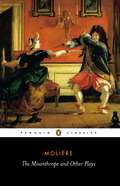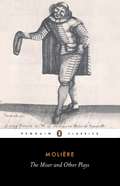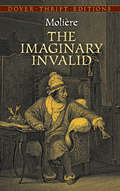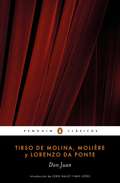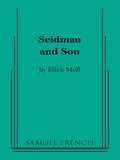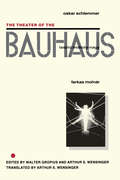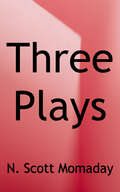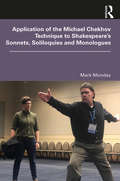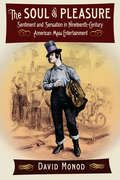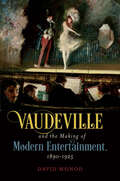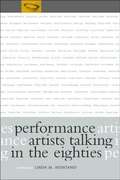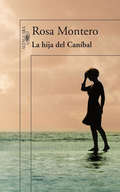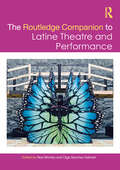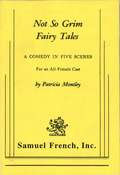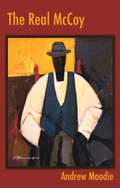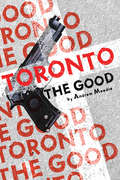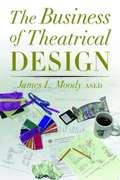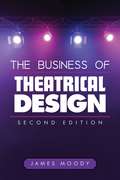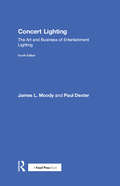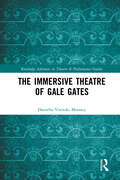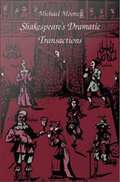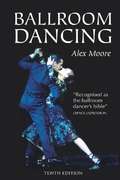- Table View
- List View
The Misanthrope and Other Plays
by Jean-Baptiste MoliereIn the seventeenth century, Molière raised comedy to the pitch of great art and, three centuries later, his plays are still a source of delight. He created a new synthesis from the major comic traditions at his disposal. This collection demonstrates the range of Molière's comic vision, his ability to move between the broad and basic ploys of farce to the more subtle and sophisticated level of high comedy. The Misanthrope appears along with Such Preposterously Precious Ladies, Tartuffe, A Doctor Despite Himself, The Would-Be Gentleman, and Those Learned Ladies.
The Miser and Other Plays
by Jean-Baptiste MoliereMolière combined all the traditional elements of comedy - wit, slapstick, spectacle and satire - to create richly sophisticated and enduringly popular dramas. The Miser is the story of Harpagon, a mean-spirited old man who becomes obsessed with making money out of the marriage of his children, while The Hypochondriac, another study in obsession, is a brilliant satire on the medical profession. The School for Wives, in which an ageing domestic tyrant is foiled in his plans to marry his young ward, provoked such an outcry that Molière followed it with The School for Wives Criticized - a witty retort to those who disapproved of the play's supposed immorality. And while Don Juan is the darkest and most tragic of all the plays in this collection, it still mocks the soullessness of the skinflint with scathing irony.
The Imaginary Invalid
by Molière Henri Van LaunThe greatest writer of French classic comedy, the 17th-century playwright Molière was one of the most brilliant satirists in the history of literature. His keen observations and barbed wit deflated the pretensions of society in his day and focused a brilliant light on the universal frailties of humanity.The Imaginary Invalid, one of Molière's funniest and most incisive satires, is also among the most performed worldwide and perennially studied in world literature courses. In this entertaining gem, a hypochondriac, victimized by two pompous doctors, tests his daughter's loyalty and discovers the greed and contempt of his scheming wife.
Tartuffe or the Hypocrite
by Molière Curtis Hidden PageTartuffe a "man of God" uses his connections to swindle his generous host Orgon out of his wealth and his wife. [This text is listed as an example that meets Common Core Standards in English language arts in grades 11-12 at http://www.corestandards.org.]
Don Juan (Los mejores clásicos)
by Tirso De Molina Molière Lorenzo Da PonteLos mejores libros jamás escritos. «A mí la belleza me encanta dondequiera que la encuentre y cedo con facilidad a esa dulce violencia a la que nos arrastra.»Molière Leyenda popular, Don Juan se convirtió en personalidad literaria con el drama trágico El burlador de Sevilla, de Tirso de Molina. A partir de entonces protagonizó como héroe-villano obras de teatro, novelas y poemas, hasta convertirse en un carácter universal, comparable a Don Quijote, Hamlet y Fausto. Además del texto fundacional de Tirso de Molina, en este volumen recogemos por su relevancia el drama de Molière y el libreto de Lorenzo da Ponte para la ópera de Mozart Don Giovanni, que aquí presentamos en edición bilingüe. Un análisis del Don Juan como arquetipo de la literatura y el cine, a cargo de Jordi Balló y Xavier Pérez, acompaña las tres grandes obras que asentaron las bases del mito. De este modo, el presente volumen nos acerca a un personaje que ha seducido, como solo él puede, a lectores de todas las épocas. Gustave Flaubert dijo...«Las tres cosas más hermosas del mundo son: el mar, Hamlet y Don Juan.»
Seidman & Son
by Elick MollComedy \ 9 m., 10 f. \ 5 Ints. \ Morris Seidman is a lovable guy who has come up the hard way. His daughter is boy crazy and his son is a militant idealist. Morris has problems at work, too, due to hiring his son. Morris not only loses one of his biggest buyers, but loses some of his most valuable workers. But he did not get to his present position without resources, and in his genial way he concludes about his son that every generation has to learn from its own experiences.
The Theater of the Bauhaus
by Farkas Molnar Lazlo Moholy-Nagy Walter Gropius Arthur S. Wensinger Oskar SchlemmerFew creative movements have been more influential than the Bauhaus, under the leadership of Walter Gropius. The art of the theater commanded special attention. The text in this volume is a loose collection of essays by Oskar Schlemmer, Laszlo Moholy-Nagy, and Farkas Molnár (who in an illustrated essay shares his vision of a total theatre space), with an introduction by Bauhaus leader Walter Gropius. Originally published in German in 1924, Die Bühne im Bauhaus was translated by A. S. Wensinger and published by Wesleyan in 1961. It was prepared with the full cooperation of Walter Gropius and his introduction was written specially for this edition.From Bauhaus experiments there emerged a new aesthetic of stage design and presentation, a new concept of "total theater." Its principles and practices, revolutionary in their time and far in advance of all but the most experimental stagecraft today, were largely the work of Oskar Schlemmer, Laszlo Moholy-Nagy, and their students. Profusely illustrated and startling in its typography (the work of Moholy-Nagy), the 1924 volume quickly became a collector's item and is now virtually unobtainable. Those interested in the stage, the modern visual arts, or in the bold steps of the men of genius who broadened the horizons of aesthetic experience will appreciate that this translation is available again.
Three Plays: The Indolent Boys, Children of the Sun, and the Moon in Two Windows (Stories and Storytellers Series)
by N. Scott MomadayLong a leading figure in American literature, N. Scott Momaday is perhaps best known for his Pulitzer Prize-winning House Made of Dawn and his celebration of his Kiowa ancestry, The Way to Rainy Mountain. <p><p>Momaday has also made his mark in theater through two plays and a screenplay. Published here for the first time, they display his signature talent for interweaving oral and literary traditions. <p><p>The Indolent Boys recounts the 1891 tragedy of runaways from the Kiowa Boarding School who froze to death while trying to return to their families. The play explores the consequences, for Indian students and their white teachers, of the federal program to "kill the Indian and save the Man." <p><p>A joyous counterpoint to this tragedy, Children of the Sun is a short children's play that explains the people's relationship to the sun. <p><p>The Moon in Two Windows, a screenplay set in the early 1900s, centers on the children of defeated Indian tribes, who are forced into assimilation at Carlisle, Pennsylvania, where the U.S. government established the first off-reservation boarding school. <p><p>Belonging with the best of Momaday's classic writing, these plays are works of a mature craftsman that preserve the mythic and cultural tradition of unique tribal communities in the face of an increasingly homogeneous society.
Application of the Michael Chekhov Technique to Shakespeare’s Sonnets, Soliloquies and Monologues
by Mark MondayApplication of the Michael Chekhov Technique to Shakespeare’s Sonnets, Soliloquies, and Monologues illustrates how to apply the Michael Chekhov Technique, through exercises and rehearsal techniques, to a wide range of Shakespeare’s works. The book begins with a comprehensive chapter on the definitions of the various aspects of the Technique, followed by five chapters covering Shakespeare’s sonnets, comedies, tragedies, histories, and romances. This volume offers a very specific path, via Michael Chekhov, on how to put theory into practice and bring one’s own artistic life into the work of Shakespeare. Offering a wide range of pieces that can be used as audition material, Application of the Michael Chekhov Technique to Shakespeare’s Sonnets, Soliloquies, and Monologues is an excellent resource for acting teachers, directors, and actors specializing in the work of William Shakespeare. The book also includes access to a video on Psychological Gesture to facilitate the application of this acting tool to Shakespeare’s scenes.
The Soul of Pleasure: Sentiment and Sensation in Nineteenth-Century American Mass Entertainment
by David MonodShow business is today so essential to American culture it's hard to imagine a time when it was marginal. But as David Monod demonstrates, the appetite for amusements outside the home was not "natural": it developed slowly over the course of the nineteenth century. The Soul of Pleasure offers a new interpretation of how the taste for entertainment was cultivated. Monod focuses on the shifting connection between the people who built successful popular entertainments and the public who consumed them. Show people discovered that they had to adapt entertainment to the moral outlook of Americans, which they did by appealing to sentiment.The Soul of Pleasure explores several controversial forms of popular culture—minstrel acts, burlesques, and saloon variety shows—and places them in the context of changing values and perceptions. Far from challenging respectability, Monod argues that entertainments reflected and transformed the audience’s ideals. In the mid-nineteenth century, sentimentality not only infused performance styles and the content of shows but also altered the expectations of the theatergoing public. Sentimental entertainment depended on sensational effects that produced surprise, horror, and even gales of laughter. After the Civil War the sensational charge became more important than the sentimental bond, and new forms of entertainment gained in popularity and provided the foundations for vaudeville, America’s first mass entertainment. Ultimately, it was American entertainment’s variety that would provide the true soul of pleasure.
Vaudeville and the Making of Modern Entertainment, 1890–1925
by David MonodToday, vaudeville is imagined as a parade of slapstick comedians, blackface shouters, coyly revealed knees, and second-rate acrobats. But vaudeville was also America's most popular commercial amusement from the mid-1890s to the First World War; at its peak, 5 million Americans attended vaudeville shows every week. Telling the story of this pioneering art form's rise and decline, David Monod looks through the apparent carnival of vaudeville performance and asks: what made the theater so popular and transformative? Although he acknowledges its quirkiness, Monod makes the case that vaudeville became so popular because it offered audiences a guide to a modern urban lifestyle. Vaudeville acts celebrated sharp city styles and denigrated old-fashioned habits, showcased new music and dance moves, and promulgated a deeply influential vernacular modernism. The variety show's off-the-rack trendiness perfectly suited an era when goods and services were becoming more affordable and the mass market promised to democratize style, offering a clear vision of how the quintessential twentieth-century citizen should look, talk, move, feel, and act.
Performance Artists Talking in the Eighties
by Linda M. MontanoThe interaction of the performance artist Linda Montano with other performance artists to consider how early events associated with sex, food, money/fame, or death/ritual resurfaced in their later work has resulted in a talking performance that documents the production of art in a misunderstood community. Her discussions with more than 100 artists, focused on the relationship between art and life, history and memory, the individual and society, and the potential for individual and social change.
La hija del Caníbal
by Rosa MonteroLucía lleva diez años con Ramón. Sus vidas transcurren sin pasiones ni tropiezos, hasta el día en que deciden pasar el fin de año en Viena y Ramón desaparece en el aeropuerto. PREMIO NACIONAL DE LAS LETRAS 2017 Lucía no se conforma con que sea la policía quien resuelva la misteriosa desaparición de su marido y, gracias a la ayuda de Adrián, un extraño joven, y del anarquista Fortuna, investiga por su cuenta el paradero de Ramón... De esta forma, algo que en principio parecía un drama, se convierte en una oportunidad para vivir con más intensidad. ** Premio Leyenda 2019 concedido por la Asociación de Librerías de Madrid El crítico literario Santos Sanz Villanueva dijo...«Estamos en la más novelesca de las novelas de Montero, a la vez que, aunque parezca una paradoja, en la más realista, en la que cala con mayor hondura y verdad en los fantasmas, complejidades, limitaciones y grandeza de la existencia.»
The Routledge Companion to Latine Theatre and Performance (Routledge Companions)
by Noe Montez Olga Sanchez SaltveitThe Routledge Companion to Latine Theatre and Performance traces how manifestations of Latine self-determination in contemporary US theatre and performance practices affirm the value of Latine life in a theatrical culture that has a legacy of misrepresentation and erasure.This collection draws on fifty interdisciplinary contributions written by some of the leading Latine theatre and performance scholars and practitioners in the United States to highlight evolving and recurring strategies of world making, activism, and resistance taken by Latine culture makers to gain political agency on and off the stage. The project reveals the continued growth of Latine theatre and performance through chapters covering but not limited to playwriting, casting practices, representation, training, wrestling with anti-Blackness and anti-Indigeneity, theatre for young audiences, community empowerment, and the market forces that govern the US theatre industry. This book enters conversations in performance studies, ethnic studies, American studies, and Latina/e/o/x studies by taking up performance scholar Diana Taylor’s call to consider the ways that “embodied and performed acts generate, record, and transmit knowledge.”This collection is an essential resource for students, scholars, and theatremakers seeking to explore, understand, and advance the huge range and significance of Latine performance.
Not So Grimm Fairy Tales
by Patricia MontleySatire / 15f (doubling possible) / Bare stage / Five scenes present unusual variations on familiar tales. In Little Red and the Big Bad She Wolf Red is invited by Mae Wolf to quit Harvard Business School and get a start in the service selling business despite Granny's opposition (she is Mae's senior partner). In Bumble Stiltskin and the Baby Business Rumpel's put upon wife implores the Queen to keep her royal baby and offers to set up a Day Care Center if she gets government support. Also included are Snow White and the Anti Freeze, Jack and the Marijuana Stalk and Cinderella.
The Real McCoy
by Andrew MoodieElijah McCoy, born in Canada to runaway American slaves, showed so much promise in school that he won a scholarship to study mechanical engineering at Edinburgh University. McCoy moved to the US, where no one believed a black man could be an engineer and so he was set to stoking boilers. Nevertheless, McCoy devised a solution to one of the greatest problems facing steam locomotion that was sold worldwide with the marketers' proviso that McCoy's race be concealed.
Toronto the Good
by Andrew MoodieWhen top Crown attorney Thomas Matthews, a victim of racial profiling himself, is assigned to prosecute the accused against a Left-leaning white attorney, tensions mount and personal politics bubble to the surface. Cutting deep into the lawyers' private lives, their families and foibles are richly portrayed as an integral part of Toronto's shifting mosaic. From an ostensibly routine traffic stop, each character must come to terms with the city's racial politics and how they have shaped their own beliefs and prejudices. Written in response to the rise of gun crime in the streets of Canada's largest city, Toronto the Good probes the problems that perpetuate the changing metropolis and explores how they have been allowed to flourish.
The Business of Theatrical Design
by James MoodyFor theatrical design students and theater professionals, here is the essential guide to marketing your skills, furthering your career, and operating a successful business! In The Business of Theatrical Design, design veteran James Moody shares his proven techniques to help costume, scenic, and lighting designers become successful businesspeople. Here is the latest information regarding IRS, state, and business liabilities; salary and fee scales; equipment costs; professional organizations; union and contract issues; and much more. Plus dozens of working producers, promoters, and designers share their insights and offer a thorough, true-to-life profile of this competitive industry. An indispensable resource for anyone looking to pursue a career in the theater!
The Business of Theatrical Design, Second Edition
by James MoodyWritten by a leading design consultant and carefully updated with the latest information on the industry, this is the essential guide to earning a living, marketing skills, furthering a design career, and operating a business. With more than thirty years of backstage and behind-the-scenes experience in theater, film, television, concerts, and special events, James Moody shares his success secrets for the benefit of design students and working designers. Topics include: Finding and landing dream assignmentsNegotiating feesSetting up ideal working spacesBuilding the perfect staffOvercoming fears of accounting and record-keepingChoosing the right insuranceJoining the right unions and professional organizationsAnd more In addition to revealing how to get the great design jobs in traditional entertainment venues, the author shows designers how to think outside the box and seize creative, lucrative opportunities—such as those in theme parks, in concert halls, and with architectural firms. Providing the keys for passionate, talented designers to become successful businesspeople, The Business of Theatrical Design is a must-read for novices and established professionals alike.
Concert Lighting: The Art and Business of Entertainment Lighting
by James Moody Paul DexterConcert Lighting: Tools, Techniques, Art, and Business Fourth Edition provides readers with an updated look at how to succeed in the complex world of concert lighting design and technology. The authors have reorganized the book into three comprehensive and thoroughly revised sections, covering history, equipment and technology, and design, and containing new information on LED technology, pixel mapping, projection options, media servers, automated lighting, solutions for moving lights, DMX, and Ethernet problems, and designer communication and collaboration. This book also explores the cross-media use of concert lighting techniques in film, video, theatre, and the corporate world, highlighted with advice from master designers such as Bruce Rodgers, Cosmo Wilson, and Sarah Landau. From securing precious contracts to knowing the best equipment to use to design a show, Concert Lighting covers everything a designer needs to know about working in the touring industry.
The Cambridge Companion To British Theatre, 1730-1830
by Jane Moody Daniel O'QuinnThis Companion offers a wide-ranging and innovative guide to one of the most exciting and important periods in British theatrical history. The scope of the volume extends from the age of Garrick to the Romantic transformation of acting inaugurated by Edmund Kean. It brings together cutting-edge scholarship from leading international scholars in the long eighteenth century, offering lively and original insights into the world of the stage, its most influential playwrights and the professional lives of celebrated performers such as James Quin, George Anne Bellamy, John Philip Kemble, Dora Jordan, Fanny Abington and Sarah Siddons. The volume includes essential chapters about eighteenth-century acting, production and audiences, important surveys of key theatrical forms such as tragedy, comedy, melodrama and pantomime as well as a range of exciting thematic essays on subjects such as private theatricals, 'black' theatre and the representation of empire.
The Immersive Theatre of GAle GAtes (Routledge Advances in Theatre & Performance Studies)
by Daniella Vinitski MooneyThis book focuses on experimental theatre company, GAle GAtes, credited as "the true innovator" of the contemporary immersive movement. The Immersive Theatre of GAle GAtes is a case-study of this little-known but visionary company, with a focus on its development and dramaturgy. Through rare archival and primary research, as well as historical context, the text chronicles company narrative and celebrates the artistic impulse. The book employs descriptive-narrative and dramaturgical analysis and is composed of historical research, rare archives, and primary source interviews. Chapters focus on the trajectory of the avant-garde leading up to the climate in which the company formed, company formative years, and major works and a discussion on the interdisciplinary and theoretical frameworks critical to its understanding. This study will be of great interest to students and scholars in theatre and performance studies and essential reading for theatre artist and historian alike, with a focus on the experimental theatre landscape.
Shakespeare's Dramatic Transactions
by Michael E. MooneyShakespeare's Dramatic Transactions uses conventions of performance criticism--staging and theatrical presentation--to analyze seven major Shakespearean tragedies: Hamlet, Othello, King Lear, Macbeth, Antony and Cleopatra, Richard II, and Richard III. As scholars and readers increasingly question the theoretical models used to describe the concepts of "mimesis" and "representation," this book describes how the actor's stage presentation affects the actor's representational role and the ways in which viewers experience Shakespearean tragedy. Michael Mooney draws on the work of East German critic Robert Weimann and his concept of figurenposition--the correlation between an actor's stage location and the speech, action, and stylization associated with that position--to understand the actor/stage location relationship in Shakespeare's plays. In his examination of the original staging of Shakespeare's tragedies, Mooney looks at the traditional interplay between a downstage "place" and upstage "location" to describe the difference between non-illusionistic action (often staged near the audience) and the illusionistic, localized action that characterizes mimetic art. The innovative and insightful approach of Shakespeare's Dramatic Transactions brings together the techniques of performance criticism and the traditional literary study of Shakespearean tragedy. In showing how the distinctions of stage location illuminate the interaction among language, representation, Mooney's compelling argument enhances our understanding of Shakespeare and the theater.
Ballroom Dancing (Performing Arts Ser.)
by Alex MooreNow in its tenth edition, this classic and comprehensive handbook has been revised to bring it up to date in keeping with changes on the dance floor and in the rules of dance competitions. The Quickstep, Waltz, Foxtrot, and Tango are all illustrated and described in great detail.
